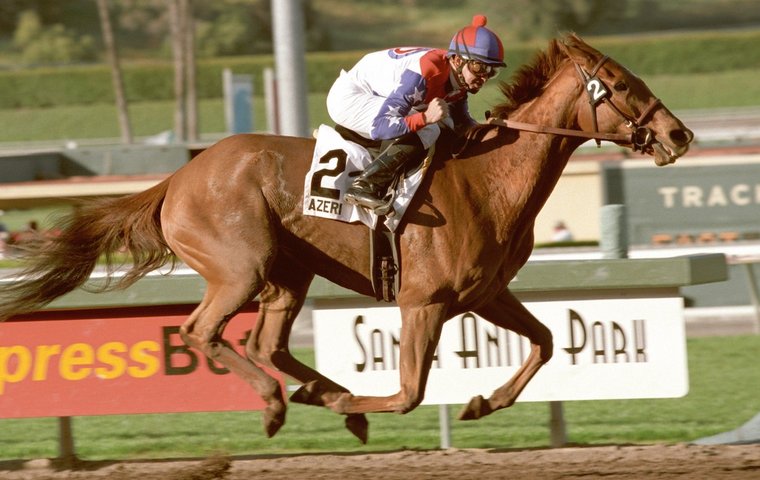
Jay Hovdey’s unmissable series continues with a female Horse of the Year who seldom seems to receives the recognition she deserves compared to her fellow queens of the turf in a halcyon era for fillies and mares.
Thoroughbred racing fans lucky enough to live in a ‘golden age’ rarely know it is happening until it has passed.
In America, there were the fabulous 1940s, when a wartime generation was entertained by Whirlaway, Count Fleet, Armed, Assault, and Citation. A cluster of international seasons in the 1960s gave forth Sea-Bird, Buckpasser, Damascus, and Dr. Fager. Then came the 1970s, which commenced with Nijinsky and tumbled on through Secretariat, Brigadier Gerard, Seattle Slew, Affirmed, and Spectacular Bid.
The most recent golden era came and went in the first decade of the 21st century. But because it was gender-specific, pop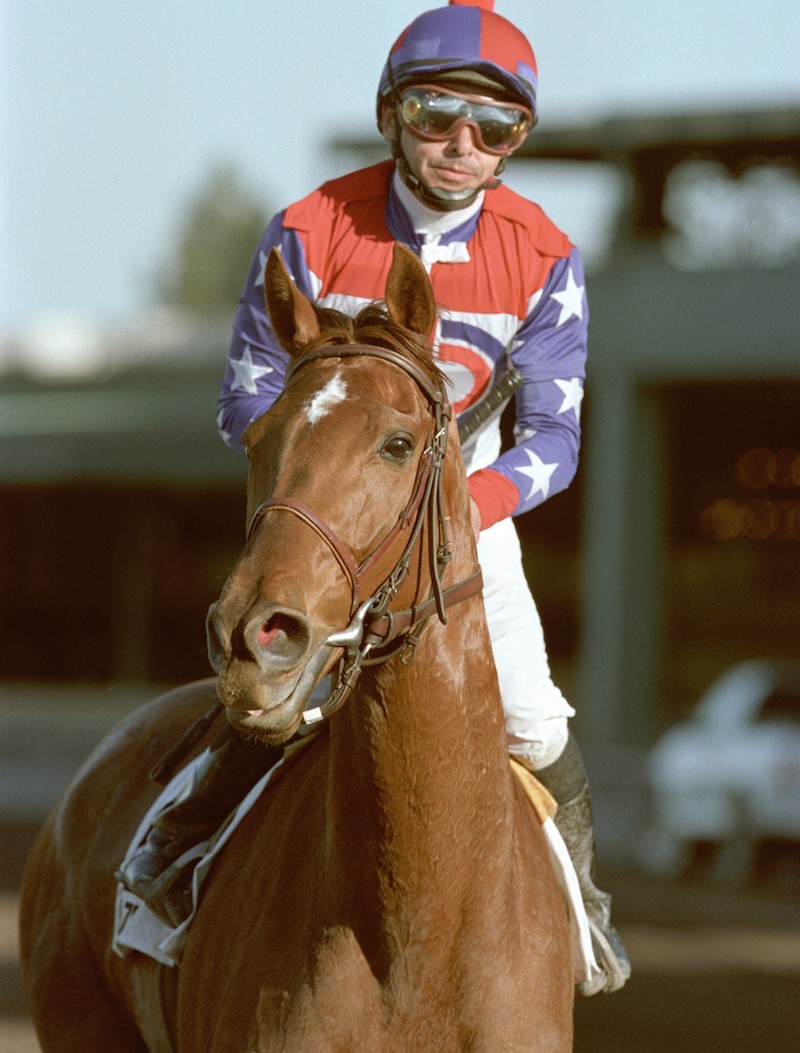 ulated by remarkable fillies and mares emerging in every corner of the racing globe, the fanfare was muted. There were no American Triple Crown winners among them, no Epsom Derby winners. There were, quite simply, the some of the very best the sport had ever seen, male or female.
ulated by remarkable fillies and mares emerging in every corner of the racing globe, the fanfare was muted. There were no American Triple Crown winners among them, no Epsom Derby winners. There were, quite simply, the some of the very best the sport had ever seen, male or female.
Consider the sweep of names that made headlines on a regular basis as the 2000s unfurled. In Japan, Vodka defeated colts in both the Japanese Derby and the Japan Cup to be twice named Horse of the Year in her native land. In Australia, the landscape was dominated first by two-time Horse of the Year Sunline and then Makybe Diva, a three-time winner of the Melbourne Cup.
In France, there was the breathtaking Zarkava, perfect in a seven-race career climaxed by a daring run to take the Prix de l'Arc de Triomphe, while Britain contributed Ouija Board, a towering presence who carried her form from her homeland to the US, Hong Kong, Dubai and back again.
Household names
The decade ended as it began, with Zenyatta, Rachel Alexandra and undefeated Black Caviar trashing the record books, eventually winning 57 of their combined 64 starts. They became household names, even beyond households that paid attention to the sport.
But if there is one worthy individual who has slipped to the edges of the era, a mare with a record that stacks neatly alongside the rest of the gilded pack, it is that tightly knit chestnut who reigned as the 2002 Eclipse Award Horse of the Year, North America’s highest honor.
Her name is Azeri.
She was easy to adore, winning race after race – 15 of 17 at one point – lounging between starts in her sun pen outside the barn of Laura De Seroux at the San Luis Rey Downs Training Center, just inland from Del Mar.
The mild California days through the 2002 and 2003 seasons would lighten her coat to a shade of warm honey, as the ocean breeze would find its way from the coast to fill her nostrils with a medley of curious scents.
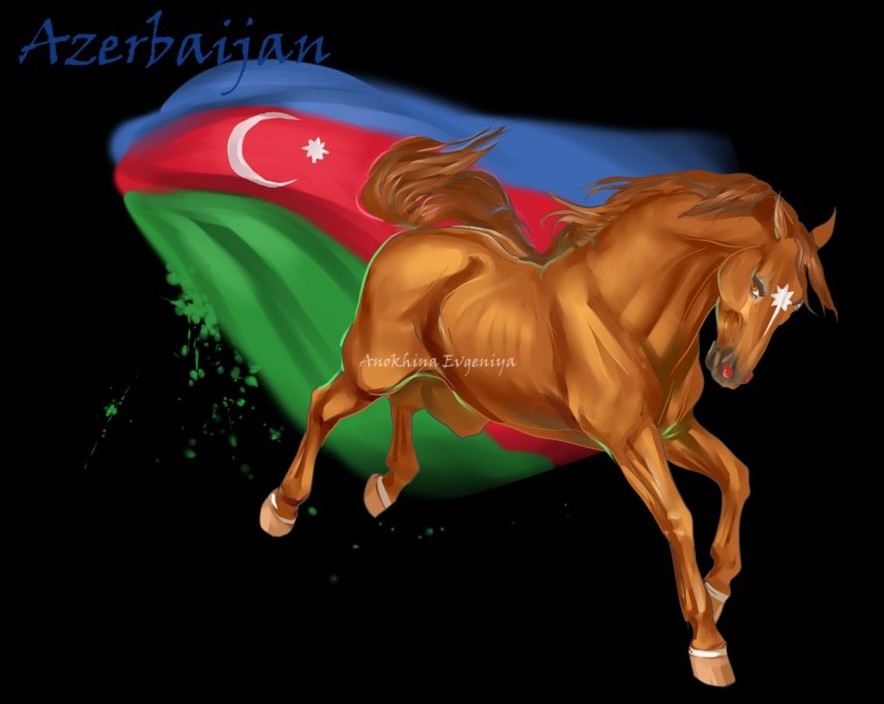 Flighty moments
Flighty moments
Azeri had her flighty moments – the commotion of the starting gate was upsetting in her youth – but she became a willing and dedicated athlete who quite literally would walk into her bridle each morning, then pose at the track to survey the world she had come to rule.
Bred by aerospace entrepreneur Allen Paulson, Azeri was by Jade Hunter, a cracking good son of Mr. Prospector who won a pair of G1 events in Florida and was in top form when a broken cannon bone ended his racing career.
She was named in recognition of Paulson’s oil exploration interests in the national of Azerbaijan, whose travel industry was delighted to celebrate Azeri’s exploits on the far side of the globe. The image on a travel poster exalting Azerbaijan’s history of the native Kazakh horse bears a striking resemblance to you-know-who, right down to the stylized star.
As a stallion standing at Paulson’s Brookside Farm in Versailles, Kentucky, Jade Hunter went right to work in 1989 and shuttled often between hemispheres until he was pensioned in 2009. Azeri led his list of 46 stakes winners, along with such US performers as Yagli, Stuka, Diazo, and Halory Hunter. The stallion was retired to Old Friends Equine and died in 2011, at age 27.
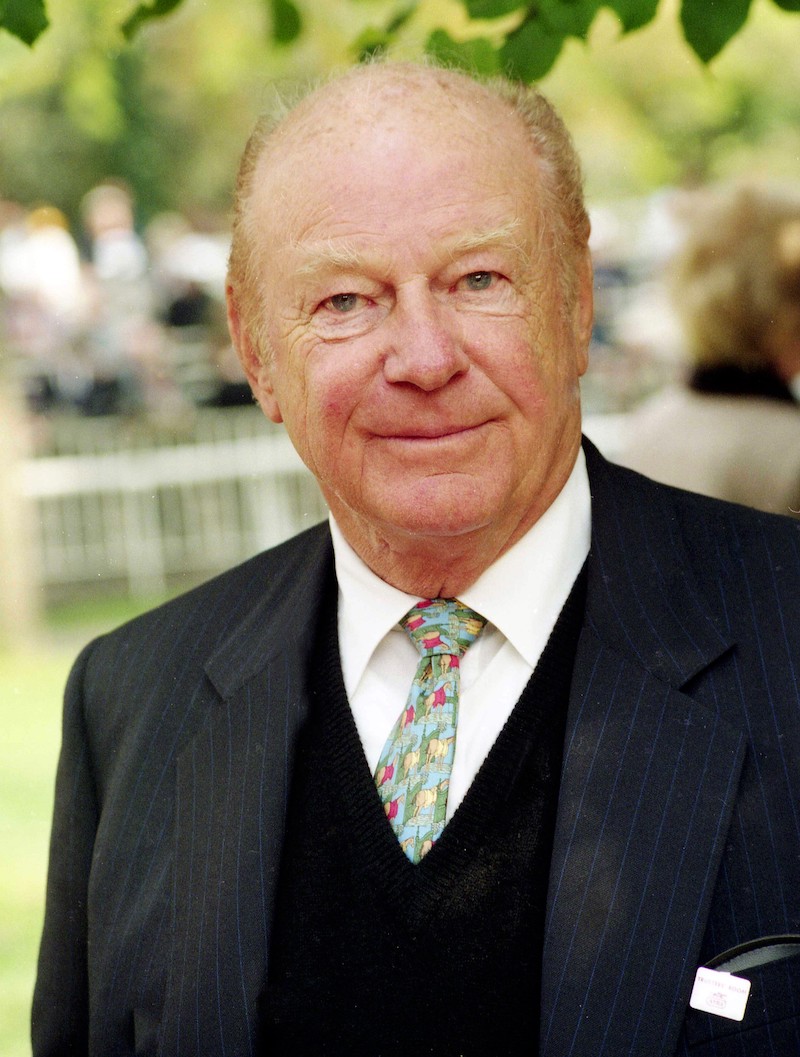 Azeri was produced by the Australian mare Zodiac Miss, a lightly-raced G3 winner purchased in 1993 by Allen Paulson to join his California stable, where she managed a minor stakes placing for trainer Alex Hassinger. She was by the prolific stallion Ahonoora, a major sprint winner in Great Britain and a son of Lorenzaccio, the horse who sent Nijinsky into retirement after beating him in the 1970 Champion Stakes at Newmarket.
Azeri was produced by the Australian mare Zodiac Miss, a lightly-raced G3 winner purchased in 1993 by Allen Paulson to join his California stable, where she managed a minor stakes placing for trainer Alex Hassinger. She was by the prolific stallion Ahonoora, a major sprint winner in Great Britain and a son of Lorenzaccio, the horse who sent Nijinsky into retirement after beating him in the 1970 Champion Stakes at Newmarket.
A deep enough dig into the female line of Zodiac Miss finds River Lady, winner of the 1982 Poule d’Essai des Pouliches, but not much more. Zodiac Miss managed only two foals before her untimely death, not long after Azeri was born. Her first foal was a colt by Blushing John, honored with the name Simon Bray, the veteran Fanduel/TVG analyst who was working with the young Paulson horses in Florida at the time, before taking over as head West Coast trainer.
Niggling ailments
Unfortunately, the trainer might have been faster afoot than his namesake. The four-legged Simon Bray never made it off the farm. However, Bray did welcome the half-sister to his stable in 2000. A handful of niggling ailments kept Azeri away from the races, but by the summer of 2001 she was nearing her first start.
“There was a morning Azeri outworked a horse who had won three races,” Bray recalled. “Julie Krone was in retirement at the time but getting on a few horses for me. She was on Azeri for that work, and I’ll never forget. I was on the pony and went galloping up to the other horse, thinking something was wrong. The rider said there was nothing wrong with his horse and pointed to Azeri: ‘That one’s a freak!’”
Allen Paulson died in July 2000, leaving behind not only his Gulfstream aerospace legacy and various holdings in oil, gaming, real estate, and automotive sales, but also a burgeoning Thoroughbred empire populated by such champions and Breeders’ Cup winners as Cigar, Arazi, Opening Verse, Ajina, Estrapade, and Escena.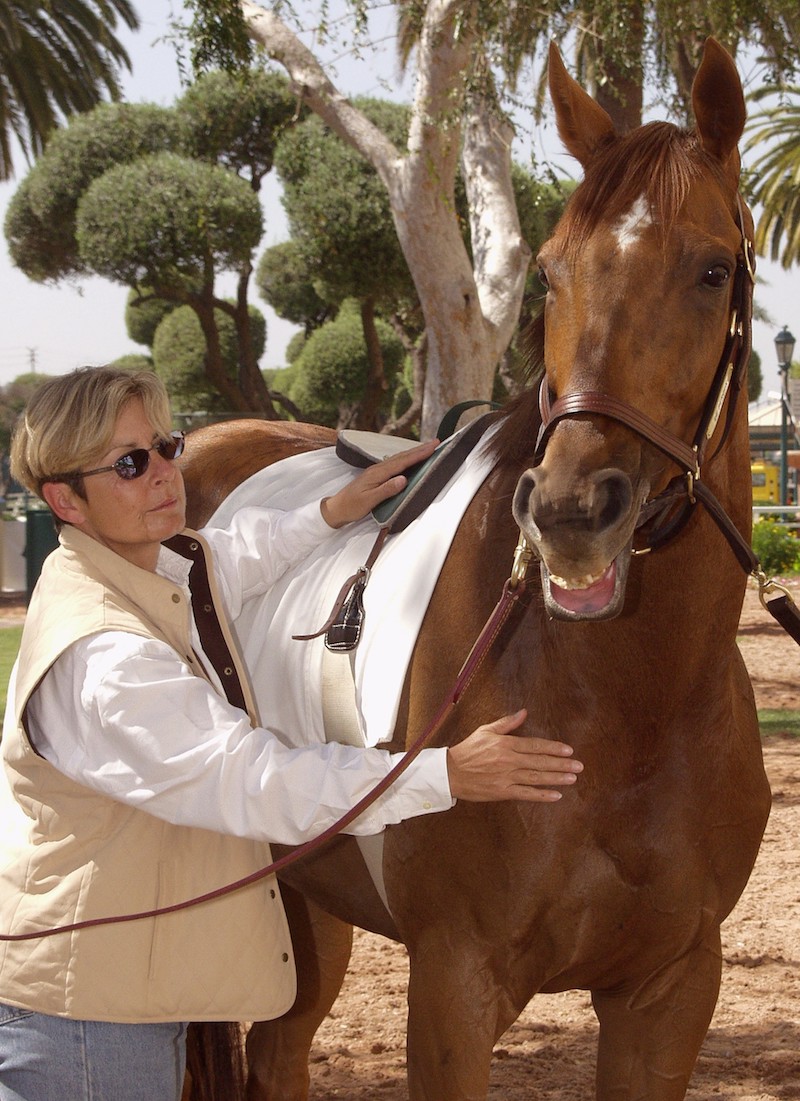
Some of the horses were placed in the Paulson estate under the control of Michael Paulson, Allen’s youngest son by his first marriage, and transferred to Laura de Seroux, wife of international bloodstock agent Emmanuel de Seroux, who was advising the younger Paulson on the resolution of the Thoroughbred assets.
As an exercise rider in her youth, Laura de Seroux worked for Charlie Whittingham, the legendary trainer of Ack Ack, Ferdinand, and Sunday Silence. When she took up training, Whittingham’s voice was always in her ear.
“Charlie was all about routine for horses,” De Seroux said. “He said they did their best doing the same thing at the same time each day, and not give them too much to think about. He also prized consistency in a horse above all things. That’s why I was so proud of Azeri’s record.”
Over time, Azeri and her immediate caretakers became the calm, steady eye of an ongoing storm that raged between Michael Paulson and Madeleine Paulson, who was married to Allen Paulson at the time of his death.
Jaw-dropping workout
Azeri had been entered in the 2001 November sale of bloodstock at Keeneland, but after a “jaw-dropping” workout for De Seroux she was withdrawn from the auction and instead made her debut on the first day of November, with Mike Smith in the saddle. They scored by six lengths at 17-1, shading 1:09 for six furlongs.
In the racing world of 2023, such a debut in California would launch a horse immediately into stakes company, not because it is a good idea, but because the intermediate allowance races do not attract enough entrants.
De Seroux, on the other hand. had the luxury of winning two allowance races at roughly one-month intervals before stepping Azeri into stakes company. When she did, in the La Canada Stakes for four-year-olds on Feb. 9, 2002, Azeri bobbled at the break, lost early position, and still came running late to fall only one-length short of catching the classy New York invader, Summer Colony.
That was the opposition’s last chance, at least for the ensuing year and a half, during which Azeri rattle off 11 straight victories in G1 and G2 events, all but one of them by open lengths.
‘She was all racehorse’
“She was all racehorse, and enjoyed doing it,” Mike Smith said. “So well-balanced and athletic. She was pretty easy to get along with, too, about as straightforward as a horse could be.”
After making his name in the East and Midwest – on the strength of two national championships and a pair of Eclipse Awards – Smith was a relative newcomer to Southern California when he became attached to Azeri. He credits her for kickstarting a rejuvenation of his career.
“Early on she was a bit slow leaving the gate,” Smith noted. “But once she got the hang of it, once you put her in there and the doors opened, she was gone. She had a determination that helped her put it all together when she needed to, especially when she was giving away weight. She could have won some races by eight, ten lengths, but I wasn’t about to do that with her running in so many handicaps.”
Azeri’s 2002 La Canada loss was followed by victories in the Santa Margarita Handicap at Santa Anita, the Apple Blossom Handicap at Oaklawn Park, the Milady and Vanity Handicaps at Hollywood Park, the Clement L. Hirsch Handicap at Del Mar, and the Lady’s Secret Handicap back at Santa Anita, every one of them by daylight.
But even after a near-flawless campaign into October, Azeri needed to cap her season in high style. The target was the Breeders’ Cup Distaff on Oct. 26, 2002, to be run for the first time at Arlington Park in the suburbs of Chicago. Then came trouble. In the wake of the Lady’s Secret, run on Oct. 2, her trainer noticed a spot on a ligament that was not there before.
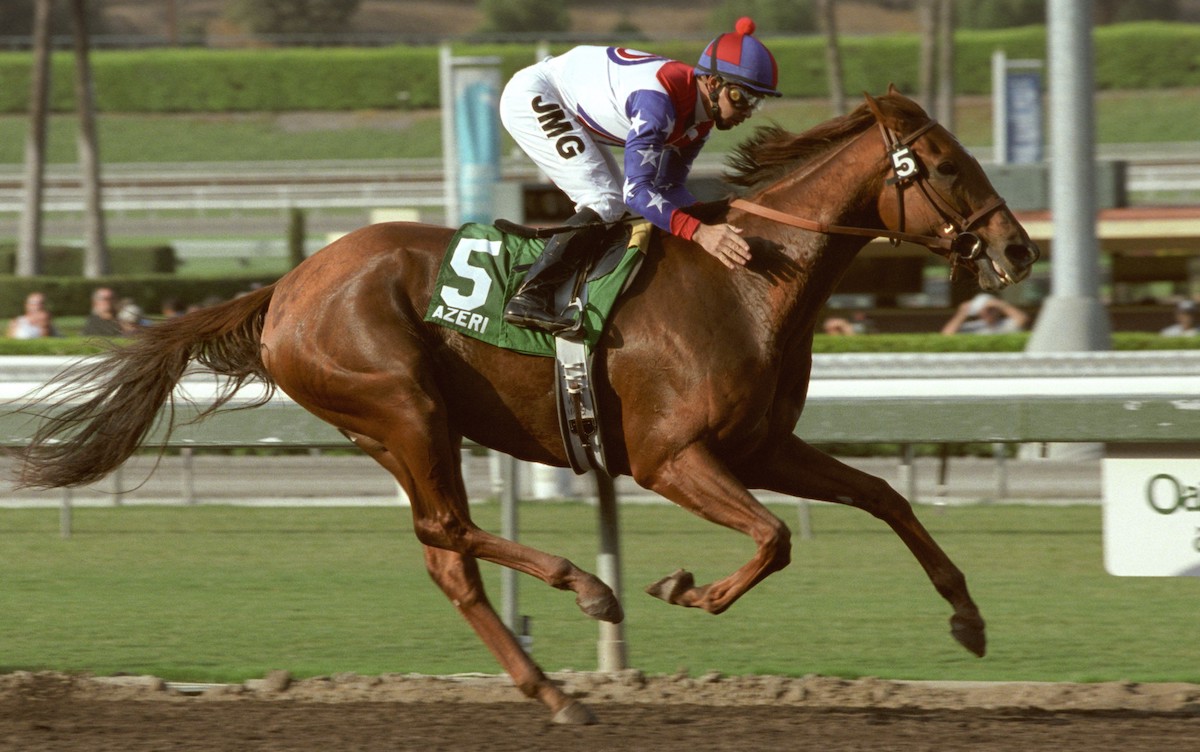 “By the time we’d quieted down the swelling, I had lost days and days of training with her,” De Seroux said. “The clock was ticking. I gave it a few more days, then worked her three-eighths, thinking that if she came out of the work without a return of the swelling, I might be okay.”
“By the time we’d quieted down the swelling, I had lost days and days of training with her,” De Seroux said. “The clock was ticking. I gave it a few more days, then worked her three-eighths, thinking that if she came out of the work without a return of the swelling, I might be okay.”
The swelling did not return. After another breeze of three furlongs, Azeri headed for Chicago, where a cold, wet autumn awaited.
“Actually, the good news was the weather,” De Seroux said. “There was rain, and the track would be off. Jade Hunter was a superior mudder, so there was no concern about the surface. In fact, her speed would be nothing but an advantage. With a clean break, I told Mike to let her roll.”
‘I’m gonna let her run today’
Given the green light, Smith brimmed with confidence. “The East Coast media was like, ‘Who’d she ever run against except the same horses in her backyard?’” Smith recalled. “I heard that and thought, ‘Man, I’m gonna let her run today.’”
Surrounded by a packed Distaff field of major stakes winners, Azeri launched herself away from the starting gate to lead every step of the mile-and-an-eighth. True to his word, Smith turned his filly loose through the final furlong, drawing off to win by five lengths. Kentucky Oaks winner Farda Amiga finished second, edging Beldame winner Imperial Gesture.
At the time, there had not been a female Horse of the Year in the US since 1986, when Lady’s Secret ran rampant to win ten of 15 starts, including the Breeders’ Cup Distaff at Santa Anita and the Whitney against males at Saratoga. Azeri’s 2002 record was unmatched, but even so, to secure the crown she needed chaos to reign in the male divisions, and she got it.
War Emblem, winner of the Kentucky Derby and Preakness, failed badly in the Belmont Stakes and Breeders’ Cup Classic, while no older male was able to win more than a single G1 event on the dirt. When the Breeders’ Cup Classic fell to the 43-1 longshot Volponi, Azeri’s chances soared. In the end, she received 189 of the 225 Eclipse Award votes cast for Horse of the Year.
At the time, the De Seroux stable was far from a one-horse show. During 2002 the barn also boasted G1 grass winners Astra and Dublino, while a new arrival, the Chilean colt Total Impact, would go on to win the 2004 Hollywood Gold Cup.
In planning an encore season for the champion, as far as De Seroux was concerned there was nothing wrong with a similar campaign in 2003. But turmoil with the estate delayed Azeri’s training until well into the new year, forcing De Seroux to creative lengths just to keep the newly-turned five-year-old mare reasonably fit with a bit of unclocked speed at the end of her routine gallops. Once the stable got the go-ahead to continue, a defense of Azeri’s Apple Blossom title became the target.
“I was nervous,” De Seroux said, as she relived the Oaklawn race. “She was not 100 per cent fit. And her main opponent, Take Charge Lady, was dead fit. My heart was in my throat the last part, but we got away with it.”
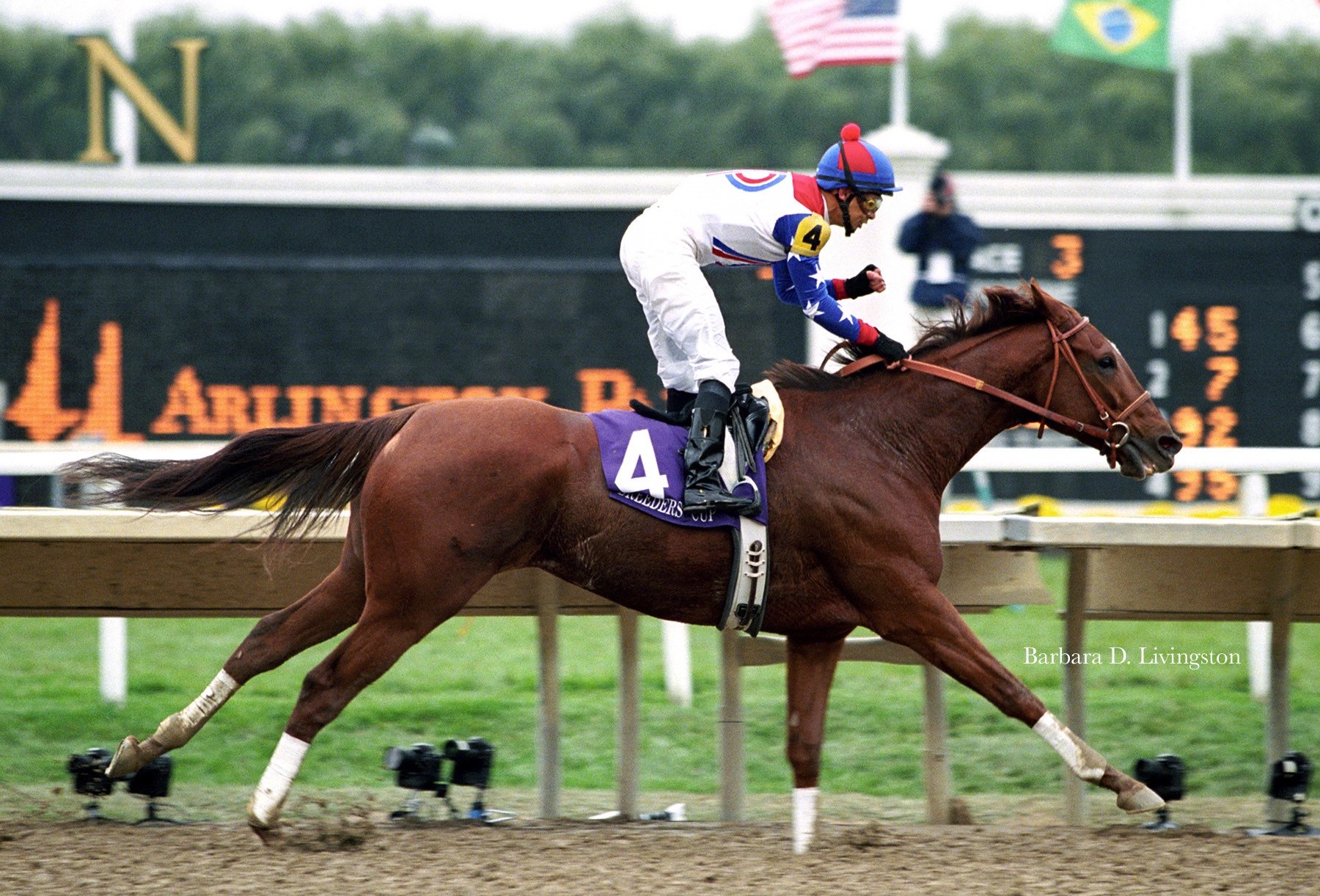 Coming from behind, Azeri hit the line just in time to edge Take Charge Lady by a head. Routine training resumed, as the Milady, the Vanity, and the Hirsch fell once again to Azeri, now giving away significant weight. As summer ended, another shot at a Breeders’ Cup prize loomed. However, when Azeri arrived to be saddled for a defense of the Lady’s Secret on Sept. 28, De Seroux sensed something amiss.
Coming from behind, Azeri hit the line just in time to edge Take Charge Lady by a head. Routine training resumed, as the Milady, the Vanity, and the Hirsch fell once again to Azeri, now giving away significant weight. As summer ended, another shot at a Breeders’ Cup prize loomed. However, when Azeri arrived to be saddled for a defense of the Lady’s Secret on Sept. 28, De Seroux sensed something amiss.
“It was a sweltering hot day,” De Seroux said. “She broke out in a glistening sweat and was trembling in the paddock. Something was really wrong, and I felt sick as I put the saddle on her. She had shown a little bit of reluctance to train, so something must have been brewing.”
Going through the motions
Carrying 128 pounds, the most of her career, Azeri went through the motions to finish third to the very good mare Got Koko, beaten about two lengths, then she was moved to second on the disqualification of runner-up Elloluv. Got Koko carried 118, which might have been a reasonable excuse for Azeri under normal circumstances. But her trainer knew better.
“She wouldn’t train after that,” De Seroux said. “It turned out she had a core lesion starting in a tendon, and she felt it.”
After 14 wins in 16 starts, De Seroux recommended that Azeri be retired. Michael Paulson, still in charge of the horses of the Allen Paulson Estate, delayed that decision and sent Azeri – along with other estate horses trained by De Seroux – to Calumet Farm in Kentucky for the winter.
The following year, Azeri reappeared in the stable of D. Wayne Lukas, who with Paulson imagined an ambitious six-year-old campaign. It began with Azeri’s third straight victory in the nine-furlong Apple Blossom.
“Early detection is everything,” De Seroux said, reflecting on Azeri’s successful return for Lukas. “She got the time off, and that’s why she made it another year. We missed her very much. But my main concern was that she stay healthy and race safely no matter what.”
After the Apple Blossom, Azeri next appeared in the Humana Distaff Handicap at Churchill Downs, running seven furlongs around one turn, a scenario she had not faced since her earliest days. She was beaten a head. Undaunted, Lukas and Paulson pointed the mare for the Metropolitan Handicap against males, replaced Smith with Pat Day, and watched as Azeri beat one horse in the field of nine.
“I hated not being able to ride her,” Smith said. “I guess winning 15 wasn’t good enough. But I was glad to see her win a few more toward the end of her career.”
Azeri summoned her old class for wins in the Go For Wand Handicap at Saratoga and Spinster Stakes at Keeneland before ending her career on a quiet note with a fifth-place finish to Ghostzapper and Roses In May in the Breeders’ Cup Classic at Lone Star Park. Despite winning just three of her eight 2004 starts, Azeri was honored with an unprecedented third straight title as champion Older Filly or Mare.
At the end of 2004, Azeri was retired to Hill n’ Dale Farm, where she produced a colt by A.P. Indy and fillies by Giant’s Causeway and Ghostzapper. Wine Princess, the daughter of Ghostzapper, went on to win the Monmouth Oaks. In 2009, while carrying a foal by Distorted Humor, Azeri was sold to the Yoshida family for $2.9 million and took up residence at their Northern Farm on the island of Hokkaido.
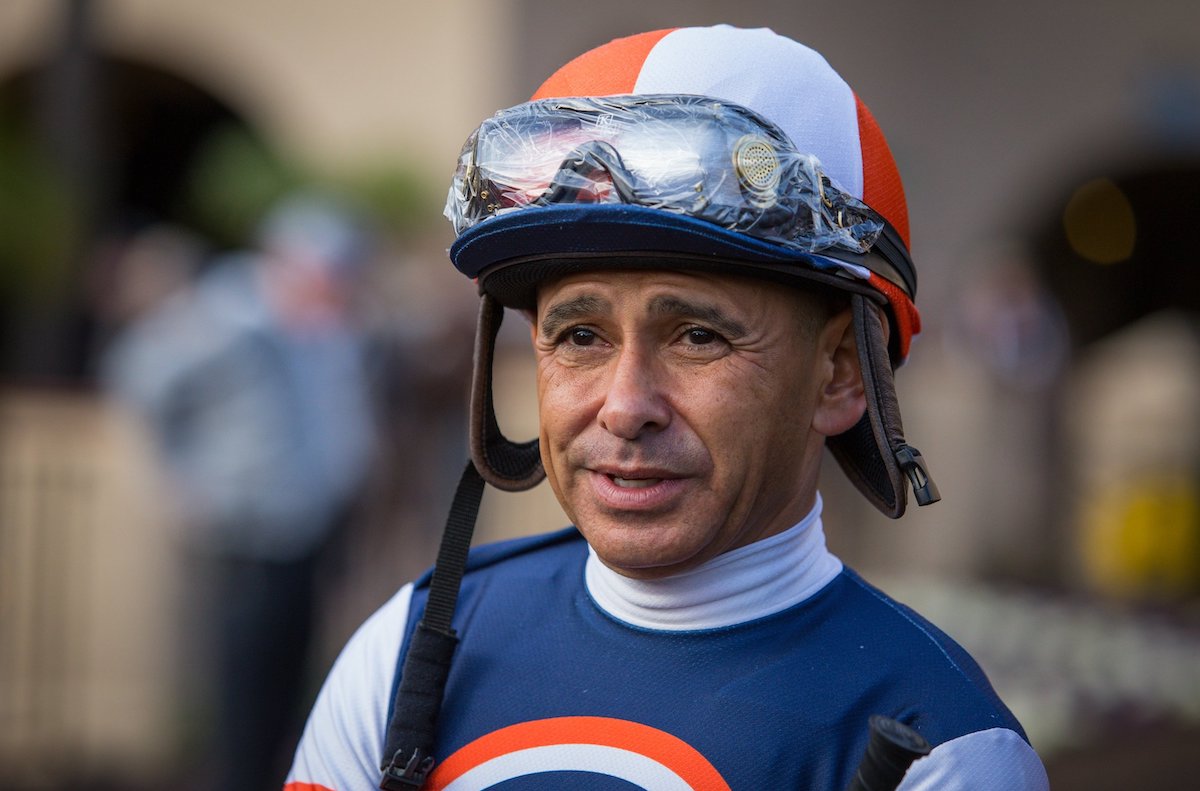 For his part, Smith continues to defy Father Time at age 57, fit as ever, taking down a collection of major prizes over the past few years with horses like Taiba, Life Is Good, Midnight Bisou, Charlatan, McKinzie, and Corniche, with whom he won a record 27th Breeders’ Cup event.
For his part, Smith continues to defy Father Time at age 57, fit as ever, taking down a collection of major prizes over the past few years with horses like Taiba, Life Is Good, Midnight Bisou, Charlatan, McKinzie, and Corniche, with whom he won a record 27th Breeders’ Cup event.
Unique timeline
Smith’s exploits aboard Azeri landed neatly on his unique timeline of association with some of history’s most famous fillies and mares. Azeri was inducted into the Hall of Fame in 2010, her first year of eligibility. Her plaque can be found in the National Museum of Racing along with the Smith mares Inside Information, Sky Beauty, Royal Delta, and Zenyatta, and will soon be joined by Songbird.
Asked the impossible question of his top choice among them, Smith predictably demurred. “There’s was no one going to beat any of them during their time,” Smith said. “But to choose one? That’s like asking to name your favorite daughter.”
Following the 2002 season, the entrance sign to San Luis Rey Downs was changed to read: ‘Home of Azeri, Horse of the Year.’
In 2007, De Seroux stepped away from training, as the first and so far the only woman to train a North American Horse of the Year. In an awful twist, the barn occupied by Azeri and the De Seroux runners was burned to the ground in the lethal fire that took the lives of 46 horses at training center in 2017. Gone too was the Azeri Tree that provided the champion with her summer shade.
Come this May 6, Azeri will turn 25. She was pensioned as a broodmare in 2021, after producing nine Japanese foals. Since then, in a retirement befitting a hard-working queen, she spends her days in grassy fields as benevolent house mother to herds of awestruck weanlings.
• Read all Jay Hovdey's features in his Favorite Racehorses series
Big Jag: ‘That’s a chunk of a horse – he put a lot of smiles on a lot of people’s faces’
Elbow room please: what’s it like to shoot an Eclipse Award-winning photo?
View the latest TRC Global Rankings for horses / jockeys / trainers / sires
View the latest TRC Global Rankings for horses / jockeys / trainers / sires


